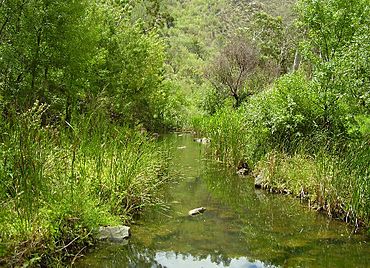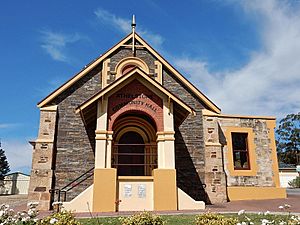Athelstone, South Australia facts for kids
Quick facts for kids AthelstoneAdelaide, South Australia |
|
|---|---|

River Torrens located at Athelstone
|
|
| Established | 1852 |
| Postcode(s) | 5076 |
| LGA(s) | City of Campbelltown |
Athelstone is a cool suburb in Adelaide, South Australia. It's part of the City of Campbelltown. It started as a small village in the 1800s. It only became a bigger part of Adelaide in the 1900s.
Athelstone is about 10 kilometers northeast of Adelaide's city center. A main road called Gorge Road goes right through Athelstone. The River Torrens, which gives Adelaide a lot of its water, runs along the edge of Athelstone. This river flows from Mount Pleasant all the way to the sea. Gorge Road also leads up into the beautiful Adelaide Hills. Another stream, Fifth Creek, flows through Athelstone too. It can sometimes flood in late spring.
Athelstone is surrounded by the River Torrens and Black Hill Conservation Park. Other boundaries include Montacute Road and Stradbroke Road.
Athelstone's Story
The first Europeans to visit Athelstone were explorers John Hill and Dr George Imlay. They camped by the Torrens River in January 1838. They were on their way to the Murray River.
The land near the river was very fertile. This meant it was great for farming. Soon, European settlers started farms here. The name Athelstone comes from a house and mill built around 1843. A man named John Coulls bought the mill in 1855. He changed it to crush grapes for wine.
The lower part of Athelstone grew into a village along the River Torrens. This is where the main shopping area began. The Athelstone Post Office opened in 1863. Later, in the 1960s, land was sold to build the senior campus of Saint Ignatius' College. New housing areas, like Foxfield Estate, were also built in the 1970s.
Some land was also set aside for nature. Wadmore Park and Black Hill Conservation Park became places for fun and nature. Black Hill Conservation Park was officially protected in 1975.
Growing vegetables was a big part of Athelstone's past. Families from Italy, like the Tunno family, came in the 1950s. They grew many types of vegetables for 30 years. They sold their produce to shops and markets in Adelaide. They grew European vegetables like endive and fennel. By 2014, only one market garden was left in Athelstone.
Fun in Athelstone
Athelstone has a big area called Athelstone Recreation Reserve. This is where a lot of sports happen. Athelstone is home to one of the oldest football clubs in South Australia. It also has the Athelstone Soccer Club and Eastern United Soccer Club. This reserve is the biggest park in the suburb.
Who Lives in Athelstone?
In 2016, about 9,150 people lived in Athelstone. Most people are middle class. There are about the same number of boys and girls. Many families are married couples, especially those aged 35 to 74. Less than 15% of people in Athelstone are over 65 years old.
About 63% of the people living in Athelstone were born in Australia. However, about 36% of people speak other languages at home. Many people have parents who were born overseas. Over 13% of Athelstone residents speak Italian. More than 4% speak Greek, and over 2% speak Chinese.
People in Athelstone work in many different jobs. The most common jobs are in retail (shops), manufacturing, health, and education. Many also work in law, property, and construction. Over 66% of workers are in these industries.
Homes in Athelstone
Athelstone has many modern houses. But you can still see older homes from the early 1900s. These older homes might have wavy metal roofs or stone walls. They are often called Californian bungalows.
The first modern houses were built in the 1970s. As more market gardens become available, new houses are still being built. Some larger blocks of land have been divided into smaller ones for more homes.


